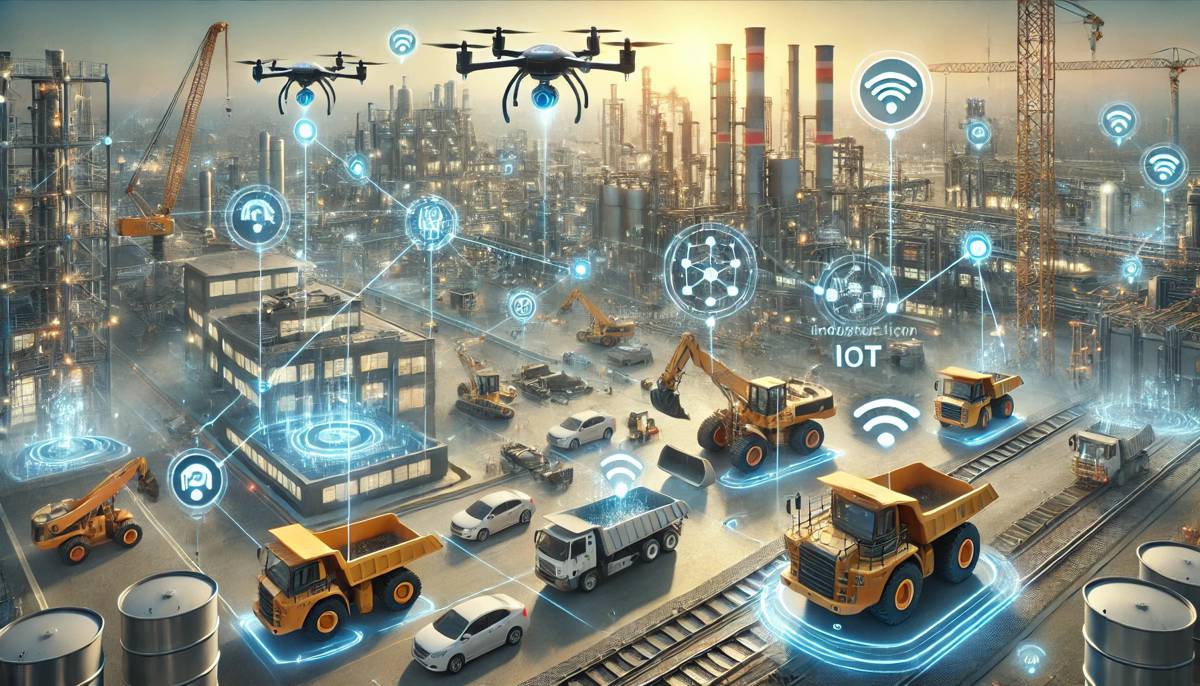The Ultimate Guide to Industrial IoT in 2024
The Industrial Internet of Things (IIoT) is no longer a futuristic concept; it has become the driving force behind the transformation of industries across the globe. From construction and mining to manufacturing and infrastructure, IIoT technologies are revolutionising business operations, boosting efficiency, reducing costs, and enhancing safety.
As we move through 2024, IIoT solutions are set to reach new heights, creating smarter, more connected environments in various sectors. Let’s explore how IIoT is reshaping the industrial landscape by offering real-time data analytics, predictive maintenance, and seamless connectivity across different industries.
The Industrial Internet of Things in 2024
The Industrial Internet of Things (IIoT) is a network of interconnected devices and systems that work together to collect, process, and analyse data in real-time. This enables businesses to make informed decisions, optimise operations, and reduce downtime.
IIoT technology uses smart sensors, embedded systems, and connectivity to drive efficiency and decision-making in industries such as construction, manufacturing, mining, and oil and gas. These industrial-grade systems are designed to handle the complex, high-demand environments where they operate, going beyond what consumer IoT devices offer in terms of reliability and scalability.
How Does IIoT Work?
IIoT functions through the integration of various technologies that enable data collection, communication, and analysis. Smart sensors collect data on operational factors like temperature, vibration, pressure, and energy consumption. This data is then transmitted using industrial communication protocols like MQTT, OPC-UA, or Modbus, ensuring the secure and efficient transfer of information.
Edge computing allows data to be processed locally, near the source, reducing latency and enabling faster decision-making. Meanwhile, cloud computing handles massive amounts of data storage and advanced analytics, providing long-term insights and supporting AI and machine learning (ML) applications. These systems predict outcomes and provide actionable insights, further automating decision-making processes.
In industries like manufacturing and construction, these interconnected systems drive automation, ensure predictive maintenance, and increase overall operational efficiency.
Technical Foundations of IIoT
IIoT relies on several key technologies and standards to ensure data flows smoothly and systems function seamlessly. These include communication protocols like OPC-UA, which enables secure data exchange in industrial settings, and IoT gateways that translate communication protocols between devices and the cloud while protecting industrial networks from cybersecurity threats.
Digital twins are another critical aspect of IIoT. They create virtual replicas of physical assets or systems, enabling businesses to monitor and manage operations in real-time. For example, in construction, digital twins can help monitor building integrity and make necessary adjustments based on real-time sensor data, improving both safety and efficiency.
Additionally, big data analytics plays a key role in processing the large volumes of data generated by IIoT systems. Predictive analytics, powered by machine learning, allows businesses to identify risks, predict equipment failures, and take preventive action before problems arise.
The Difference Between IIoT and IoT
While consumer IoT focuses on personal devices like smartwatches or home automation systems, IIoT is specifically tailored for mission-critical environments where downtime or failure can lead to significant losses or even safety hazards. IIoT solutions are designed to operate in harsh conditions, such as remote oil rigs, construction sites, or manufacturing plants, where reliability and durability are paramount.
IIoT systems handle far greater volumes of data and use robust security protocols to protect sensitive industrial information. Industrial cybersecurity strategies, such as intrusion detection systems, firewalls, and encryption protocols, are essential to safeguarding IIoT environments, where any breach could have a critical impact.
IIoT in the Construction Industry
The construction industry is experiencing a profound transformation thanks to IIoT technologies. Managing a construction site has traditionally been a complex task, with multiple stakeholders, heavy equipment, and ever-changing conditions. IIoT helps streamline these operations by providing real-time data on equipment performance, safety conditions, and project progress.
Remote monitoring allows managers to oversee every aspect of the site from anywhere, tracking fuel consumption, wear and tear, and operating hours for predictive maintenance. This ensures that equipment remains operational, reducing downtime and extending the life of valuable machinery.
In addition to equipment monitoring, IIoT fleet management solutions help companies track the location, usage, and condition of vehicles and machinery. This not only improves asset utilisation but also ensures timely maintenance and reduces fuel consumption.
The use of drones for real-time site monitoring has also revolutionised construction practices. Drones equipped with IIoT sensors can capture detailed 3D maps, track progress, and detect safety hazards. With the integration of digital twins, construction companies can create virtual models of their sites, simulating scenarios, making adjustments, and improving overall project efficiency.
IIoT in Mining
The mining industry is rapidly embracing IIoT technologies to boost operational efficiency, reduce costs, and improve worker safety. Mining operations are often vast and remote, making traditional methods of monitoring and management time-consuming and inefficient. IIoT solutions provide real-time monitoring of equipment performance, environmental conditions, and worker safety, allowing companies to optimise their operations.
IIoT systems can monitor machinery health, fuel consumption, and air quality in real-time, enabling operators to identify issues before they become critical. For example, sensors installed on mining trucks and conveyors can detect early signs of wear and tear, allowing for predictive maintenance that prevents breakdowns and reduces downtime.
Autonomous vehicles are another exciting development in mining. These vehicles, equipped with IIoT sensors, can operate in hazardous conditions without putting workers at risk. Autonomous haul trucks and drills are already improving safety and increasing productivity by working around the clock without the need for human intervention.
Factory Automation and IIoT in Manufacturing
Factory automation is one of the key areas driving the adoption of IIoT, with smart factories becoming the new norm. By integrating smart sensors, cloud-based analytics, and automated control systems, manufacturers can reduce manual intervention, increase production efficiency, and improve quality control.
Smart factories use IIoT sensors to collect data from machinery, monitor cycle times, temperature, pressure, and other key performance indicators. This data is processed in real-time, allowing the factory to make immediate adjustments that optimise production processes, reduce waste, and enhance overall equipment effectiveness (OEE).
For example, BYD, a global leader in electric vehicle and battery manufacturing, has automated over 90% of its production processes using IIoT systems. By monitoring machine performance and energy usage in real time, BYD has achieved significant cost savings and improved energy efficiency.
Automated quality control systems are another major benefit of IIoT in manufacturing. These systems use sensors and cameras to detect even the smallest defects in products, reducing the need for manual inspection and ensuring consistent quality.
IIoT and Predictive Maintenance
Predictive maintenance is one of the most valuable applications of IIoT, allowing businesses to monitor the health of their equipment in real time and predict failures before they happen. In industries like manufacturing, oil and gas, and mining, where equipment downtime can result in significant losses, predictive maintenance is a game-changer.
IIoT sensors monitor critical factors like vibration, temperature, and pressure to detect early signs of equipment malfunction. This allows companies to perform maintenance at the optimal time, reducing unplanned downtime and extending the lifespan of machinery. According to a study by GE Digital, predictive maintenance can reduce reactive maintenance costs by up to 40%, offering significant savings.
Predictive maintenance also improves spare parts management. By forecasting when a machine will need maintenance, businesses can reduce inventory costs by only stocking necessary parts.
Inventory Management and Asset Tracking
IIoT is revolutionising inventory management and asset tracking in industries like construction, logistics, and mining. Traditionally, tracking inventory and assets has been a manual, error-prone process. With IIoT, smart sensors, RFID tags, and GPS tracking offer real-time visibility into the location and condition of assets.
This enables companies to optimise supply chains, ensuring that materials and parts are available when needed. Real-time tracking also improves accuracy, eliminating human error, while reducing operational costs by automating inventory checks.
Autonomous drones and robots are increasingly being used to monitor stock levels and track assets without human intervention, allowing businesses to maintain continuous oversight 24/7.
IIoT in Oil and Gas
The oil and gas industry was one of the first sectors to adopt IIoT, using it to manage remote operations and improve asset reliability. With pipelines and drilling operations often located in harsh, remote environments, IIoT solutions provide real-time monitoring and predictive maintenance that help reduce operational costs and improve safety.
IIoT sensors monitor pipelines for signs of wear or potential leaks, allowing companies to detect issues before they escalate into costly repairs or environmental disasters. In 2024, it is estimated that the oil and gas industry will invest around £43 billion in IIoT-enabled devices and systems to improve operational efficiency.
Embracing the IIoT Revolution
In 2024, the Industrial Internet of Things is not just a trend; it is the backbone of modern industrial operations. From smart factories to autonomous mining equipment, IIoT solutions are creating more connected, efficient, and safer workplaces. By adopting these technologies, industries can reduce costs, improve safety, and future-proof their operations.
As IIoT continues to evolve, businesses that embrace this revolution will lead the next wave of industrial innovation, ensuring that they remain competitive in an increasingly data-driven world.




















